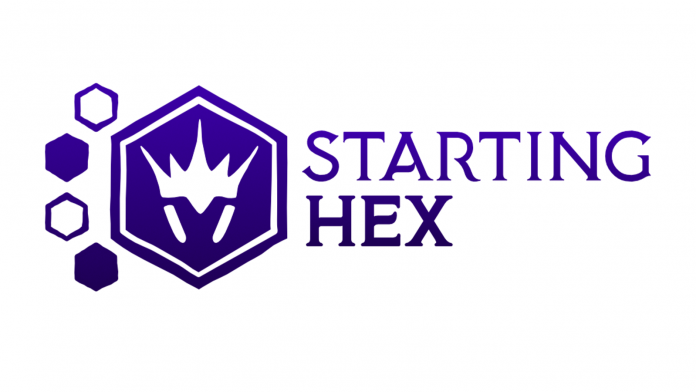Welcome to another installment of Starting Hex, a series about Warhammer Underworlds. This time around, we’re going to take a look at one of the things that sets Underworlds apart from other Games Workshop games – the cards! Specifically, how to consider card draw and evaluate how it should shape your deck building and warband evaluation.
Embergard Hold ‘Em
As mentioned above, decks of cards aren’t a common component in too many of Games Workshop’s games. There are exceptions, but for the most part these games tend to use dice as the main method of randomness and action resolution. Some editions of 40k and AoS have used a fixed deck of objective cards that are randomly drawn from during the game, but those decks are a fixed list that the players can’t modify.
Since cards are a fairly unique part to Underworlds, I thought it’d be worthwhile to briefly touch on some stuff I’ve picked up from 20+ years of playing other card games (namely Magic: the Gathering). This might not be groundbreaking information for people who are familiar with various deck building games, but I think it’s worth touching on to have everyone on the same footing.
Note: As is eerily often the case, while I was writing this article, Games Workshop dropped some surprise news that throws a wrench in it. The new Knives of the Crone warband and Realmstone Raiders rivals deck seem to be all about manipulating your deck(s), but since we don’t know the details yet this article won’t touch on them. Stay tuned for more info as it becomes available, though!
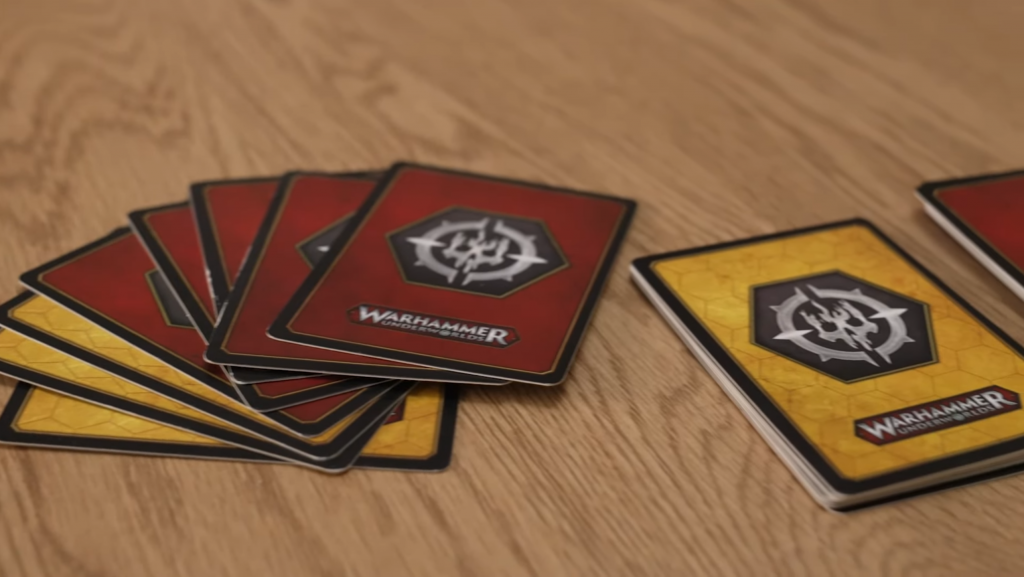
Deck Sizes
Common advice in card games is to keep your decks to the minimum legal size. In Underworlds, this would be a 12 card objective deck and a 20 card power deck. There are cases where going above these minimum sizes can be worthwhile, but it’s worth understanding what you’re sacrificing to make that choice.
One facet of this rationale is that since your deck isn’t made up of just 12 or 20 copies of one single card, you’re going to have some cards that are better than others. Since this is the case, you’re going to want to maximize the chance of drawing your best cards each game. Any cards included above the minimum required amount are going to reduce your chance of drawing those clutch cards and ensuring you can play them. Whether this is your high scoring objective that you need to pull ahead or an impactful ploy that you want to see every game to pull off a solid play, you want to bump the probability of getting your key cards up as much as you can. This is doubly important in this game because there’s no guarantee that you’ll get to see every card in your deck in each game, barring leveraging the Focus core ability or other external card draw factors.
This is one key reason why, in different games, otherwise innocuous-looking do-nothing “cantrip” cards (a card that replaces itself by having you draw a card after using it) can be surprisingly powerful. You’re effectively reducing the size of your deck which makes it more reliable to get your key cards in a timely manner. These don’t quite exist in Underworlds (yet!) but it’s worth keeping an eye out for future decks or warbands that can mimic this mechanic.
Speaking of card draw, this is a fairly uncommon mechanic for this game. Most rivals decks don’t include ways to draw additional cards and only a small percentage of warbands have card draw mechanics on their warscrolls. Card draw effects also have a larger percentage impact with a smaller deck size, so by adding additional cards to your deck size you’re effectively diluting the potency of each card draw effect in terms of drawing your best cards.
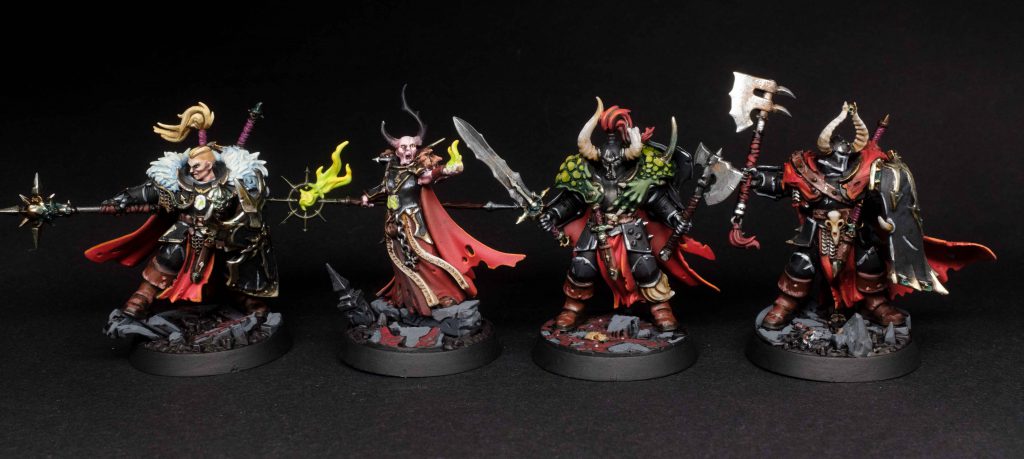
Let’s very briefly touch on the Focus core ability. Every player has access to Focus, but the cost of spending one of your twelve actions in a game on Focus is a high cost. It’s one worth paying in some circumstances, but when comparing to power cards or warscroll abilities that can be used in the power step, it has a higher demand from you as a player. One unique aspect of Focus is the ability to interact with your Objective deck – so far, most (all?) of the card draw effects in Underworlds are limited to your Power deck. Another is how you can scale the digging power by discarding more cards. If there’s one particular card you need right now, you can amp up your chance of getting it by pitching your entire hand. It’s a high cost, sure, but if you really need to draw Confusion to win the game then that is a worthy sacrifice.
On the flip side, there are times in which it’s correct to add additional cards to your decks. It’s fairly common to use a 13 card objective deck, for instance, with the intent of raising your total glory ceiling and allowing for higher scores at the end of the game provided you can reasonably get through your entire objective deck in a game. This last part is key, because if you cannot do that you’re once again diluting your deck and probably lowering the potential glory you can score. With a bit of luck and planning around what you know is in your deck, you can draw and score surges early and chain into end phase objectives to get through your deck even with 13 cards.
For your power deck, going over 20 cards again relies heavily on having external sources of card draw or willingness to spend you incredibly precious turns on the Focus core ability. There’s no free card replacement effect in play for power cards like there is for surge objectives – whatever you draw at the start of the round is all you’re going to see until the end of the round unless you have card drawing effects or choose to Focus. Adding extra cards over the minimum required to the power deck is something that requires more careful consideration and isn’t as correct of a choice as the 13th objective card, in my opinion.
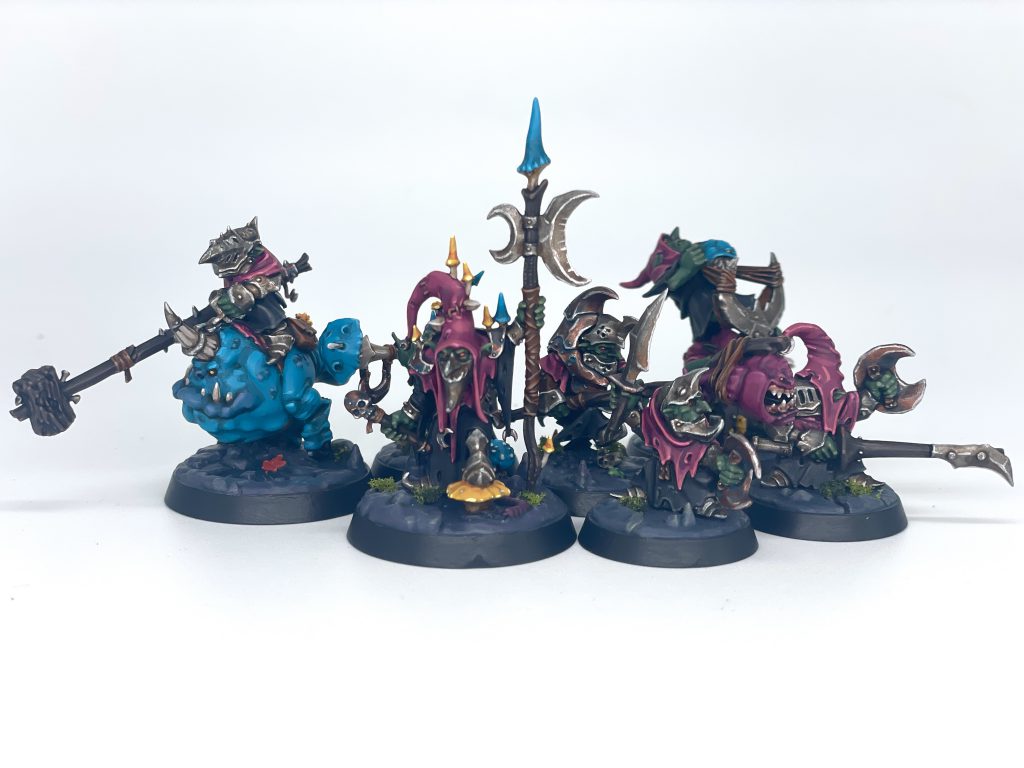
Let’s look at some really quick and fairly basic math (the only kind I am qualified to talk about!). You start every game by drawing five power cards. At the start of each subsequent round, you draw up to five again. If you’re able to play all five each round then you’ll see 15 of your 20 cards, so 75% of your power deck. Now, you’re not always guaranteed to play all five cards out each round and any time you don’t, that’s reducing the number you’ll see in a game. I’m hardly a player to emulate, but I’ve noticed I tend to carry one or two cards over between rounds fairly often. Let’s say it’s two cards carrying over after each round concludes. That’s dropping the number of power cards seen in a game to 11 – barely half of your deck! You’ll get helped out by, on average, seeing 1.5 cards extra from losing the roll off on each round (three roll offs with a 50% chance of winning any of them, so don’t go cutting any cards in half quite yet). I will safely say that there is never a reason in which I would go over the 20 card minimum in a deck and warband combination that doesn’t have access to reliable and/or multiple sources of card draw.
What if you have a certain power card that you really want to see in a game, ideally in your opening hand? This could be a ploy that “chooses” a fighter if you’re playing Spiteclaw (which is how they inspire), it could be a form of push card if you’re playing Daggok (which will also help set up inspires in addition to being generally good), or maybe you’re up against Headsmen’s Curse and want the best chance of pulling Fireproof to really throw a wrench in their assassination plans. We can whip out a hypergeometric calculator (something I learned about when crunching numbers in Magic: the Gathering) and plug some values in.
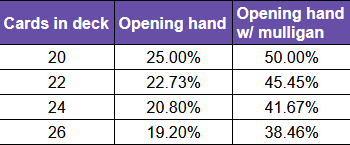
This chart shows the chances of getting one particular card from your power deck in either your opening hand either from the first set of cards you draw, or if you choose to mulligan and redraw your power hand. Due to the relatively small deck size of Underworlds, even adding two cards to the deck can shift the numbers a noticeable amount, especially if you’re in a situation where you’re playing multiple sets of best-of-three games throughout a day. The numbers change when you are looking for any one of a multiple of cards, whether you want to factor in some warband specific draws, and so on. It’s a fun tool to play with so give it a shot.
Rivals Decks with Card Draw
As touched on before, there aren’t too many rivals decks that come packing card draw mechanics. Of the decks in the Embergard box, neither of Blazing Assault nor Pillage and Plunder have any card drawing mechanics. Neither does the individually released Wrack and Ruin deck.
Countdown to Cataclysm has a single upgrade in Burnt Out that is marginally better than the Focus ability in terms of drawing cards – not only do you still have to spend an action to use it, but you also have to stagger one of your friendly fighters. The net gain in cards-in-hand is one more than when using Focus (or two if you are the underdog), but you also lose the ability to pitch dead Power cards to dig even deeper. It definitely feels weaker than other options we’ll cover. It does have the benefit of being a reusable source of card draw and that happens to be a very uncommon perk. However, again, it’s competing with Focus… which is also infinitely reusable and doesn’t require the setup of having a glory to play the upgrade in the first place.
Emberstone Sentinels has By the Numbers which is far more appealing if you’re following the gameplan outlined by that deck already. With a theoretical cap of drawing five cards in a power step, this card has one of the highest ceilings of card draw effects in the game. That ceiling is also effectively never going to be reached, so how does it stack up in a more reasonable situation? If your warband can hold a measly one treasure token, you can at least play this card to replace it with another one in your power deck. While not ideal, it effectively reduces your power deck to a minimum of 19 cards which helps ensure getting key cards later on, not to mention any bonuses for other cards that want you to play X number of ploys or have Y number of cards in your discard pile. I like to evaluate this card with the idea of having one or two treasures held. This isn’t a huge ask for a deck that’s already trying to do so, and while it’s always nice to get more than that, if you are holding three or more treasures you’re probably already in a good spot.
Reckless Fury has an interesting card in Lost Legacy. This combination card draw / recursion effect has some limitations on it, but if you look at it a certain way it’s still netting you an additional card and not just replacing itself when you play it. It has lost a little bit of its luster when three of the upgrades you would want to fetch back with it have been forsaken in Nemesis, but provided you pack some upgrades that you would like to reuse, it can still come in handy. I think the biggest things holding this card back is that it requires you to have a fighter be slain who has an upgrade that you want to recur. Sometimes your opponent won’t cooperate and won’t attack the fighter you want. If they are going after your fighters who have no upgrades, you can’t even play this card – it requires you to discard an upgrade from a slain fighter, so you don’t even have the option to use it to cycle one card through your power deck when you’d want to.
The newest deck, Edge of the Knife, has the ploy that prompted me to dive further into card draw – Power from Death is similar to Lost Legacy above in that you need to have a friendly fighter slain and your friendly fighter has stipulations for counting, but the payoff is much higher. You get to draw three power cards when it triggers. This is the equivalent to 60% of your starting power hand which is pretty dang good. It’s worth pointing out the restrictions here – you have to have a fighter that’s tempered, so you’re going to either need to have some two health fighters in your warband, have ways of making your fighters tempered either through other cards in this deck or just the old fashioned “take some damage” route, and the fighter has to die. Notably, the fighter has to be slain by an enemy fighter so you can’t do something like detonate Tik Tik nor can you benefit from an opponent using something like Trapped Cache to kill your fighter with a ploy. These hoops are ones that I will gladly attempt to jump through for the payoff, though.
Warbands with Card Draw
Having access to card draw via your warband is a step above leveraging the effect from decks. You can’t reliably count on drawing any particular card from your deck, but warscroll abilities are always there and available from turn one until the end of the game. So, which warbands offer card draw?

Khagra’s Ravagers sport a very similar ability to By the Numbers in the Emberstone Sentinel deck. Dark Approval draws a card for every desecrated treasure token, which is a slightly different criteria from holding treasures but can often offer the same or higher payoff. Considering the Ravagers are going to be leaning into their desecration mechanic pretty heavily, playing into this ability is going to line up with their gameplan naturally.
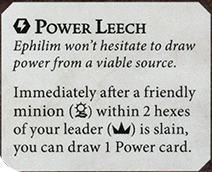
Chaos isn’t done yet, because Ephilim’s Pandaemonium (in theory) has a reusable card draw mechanic in Power Leech. This one is going to be trickier to set up and requires your opponent to play into it, so it’s not terribly reliable. Doubly so because you’ll need one of your minions to die next to Ephilim, but in my experience a lot of my opponents are just gunning for Ephilim if they’re close enough instead. If you can set up situations where the opponent has no choice but to either give you Power Leech or choose to not attack your fighters, you’ll be able to reap the reward.
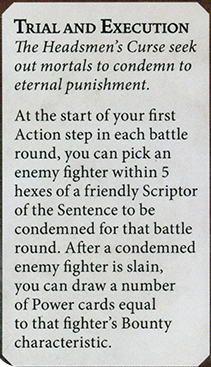
The Headsmen’s Curse has the Scriptor of the Sentence menacingly pointing at an opposing fighter and then offering a hefty reward for killing it. Through the Trial and Execution ability and inspire conditions, this warband is heavily incentivized to kill the condemned target. The amount of card draw being tied into the bounty of the opposing fighter is an interesting variable here. Fortunately, condemning one of the larger and more threatening enemy models is often the way to go, so you’re maximizing the return by default. It also doesn’t require the Scriptor to stick around, so if your opponent kills your Scriptor (after it does the initial condemning of whichever round), you can still get the payoff – even if someone other than the Wielder is the one who delivers the killing blow. Kinda nice, huh?

The second Death warband with card draw baked in is Zondara’s Gravebreakers, and boy does this warband have the potential to churn through your power deck with Unearth. There is a balancing act between keeping enough minions alive to be able to reliably use the Gravebreakers action and leaving some dead to let Unearth draw you cards. This warband is next up on my list of ones to get reps in with and I fully expect to drop the ball in trying to make the most out of Gravebreakers, but the temptation to repeatedly draw two or so cards in multiple power steps is appealing as hell. I’ll just have to make sure I don’t fall into the trap of building an intricate, multi-part card drawing machine without actually accomplishing steps to win the game. That was my common folly when playing Magic with my friends.

Destruction’s first card drawing warband is Grinkrak’s Looncourt. One of their quests, Conquer Da Realm, offers the reward of drawing two power cards alongside inspiring up to two of your fighters if you utilize your dubbed fighter in completing it. The difficulty in completing this quest in particular is going to depend on your match up – if your opponent aims for a treasure holding gameplan or has enough extra bodies to park on tokens, that could make it more challenging. It’s also the only quest that doesn’t give your dubbed fighter some kind of bonus.

Continuing the trend of each grand alliance having two warbands with card draw, Daggok’s Stab-ladz sport the Thief of Kunnin’ ability. Spreading damage out isn’t typically what you want to do in Underworlds by default. An injured fighter is just as threatening in attacks and can stand on treasures or various places of the board just as well as an uninjured one, so focus fire tends to be favored. That said, there are times when spreading out damage can be rewarding if your cards specifically request it. Some objectives in particular score from it, some power cards can ping multiple fighters, and the Stab-ladz’s own Krule Stab can aid in spreading out damage if you’re clever about maneuvering your fighters.
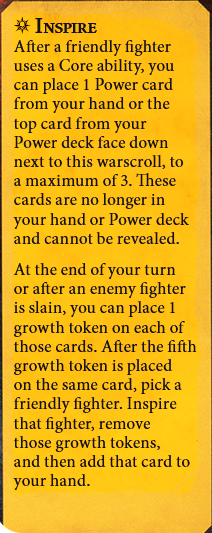
Moving over to Order, we’ll start with Ylthari’s Guardians which I would rank very highly in terms of reliability and raw number of cards drawn in a game. Their inspire ability (which doesn’t have a catchy name, sadly) involves “planting” power cards from your deck and then drawing them a few turns later. The wait can be sped up if you are able to slay enemy fighters, but it’s guaranteed to happen eventually as long as there are enough turns left in the game. The downside here is that the cards aren’t going to be drawn the first few turns and there’s a chance you won’t even see them until round two.

The final warband I’ll talk about is Cyreni’s Razors who also happen to have one of the least reliable sources of card draw in Soul Harvest. The fact that the decision is 100% in your opponent’s hands means if they don’t want you to draw power cards, you won’t. And depending on the warband you’re against, it’s often a much better plan for them to uninspire their fighter to deny the Cyreni player any cards. This is one where I’d never rely on it to draw cards – if you can manufacture a situation where uninspiring the opposing fighter is beneficial, go for it. Be pleasantly surprised if you net any cards from the exchange.
I find it amusing that the breakdown wound up involving two warbands from each grand alliance. I was expecting the trend to be broken at some point, but the pattern persisted. Neat!
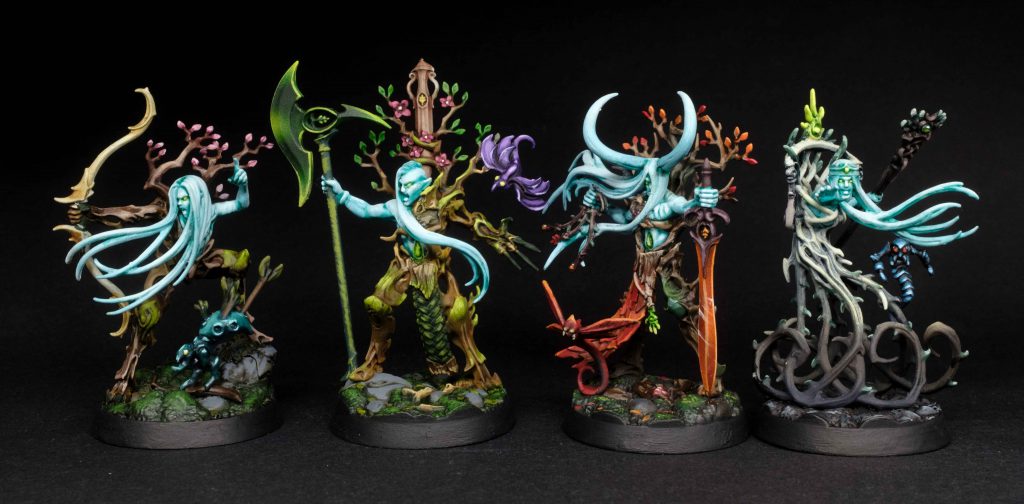
For a personal anecdote, I’m at 11 games played with Ylthari’s Guardians and I’ve routinely been able to draw my entire power deck through the course of a game. This has lead me to packing my deck with a few extras, often sitting at 22 power cards (sometimes more!) instead of the minimum of 20. My rationale was that I’m drawing everything, so I had better put more fuel in the tank so I can keep drawing. It felt like a natural conclusion until I listened to Skyler of What the Hex?! talk about the deck he took to Adepticon this year. He kept it down to 20 and I’m starting to think this is probably the right idea. If I didn’t have extra draw tech, I’d want to keep it to the minimum size to maximize my chances of getting my best cards. That doesn’t change if I’m drawing my cards faster. Sure, there’s a chance I’ll run out of stuff by the third round but that also means I’ll have managed to get all 20 of my power cards–all of which are the best options I could have selected when building the deck–even earlier. I think I’m going to cut a few cards from my current Ylthari deck and also build Zondara with a strict 20 power card deck to start with and adjust from there.
I hope this at least provides some questions to consider when building your power deck, and potentially tempts you into trying out a new warband and/or rivals deck.
Have any questions or feedback? Drop us a note in the comments below or email us at contact@goonhammer.com. Want articles like this linked in your inbox every Monday morning? Sign up for our newsletter. And don’t forget that you can support us on Patreon for backer rewards like early video content, Administratum access, an ad-free experience on our website and more.
